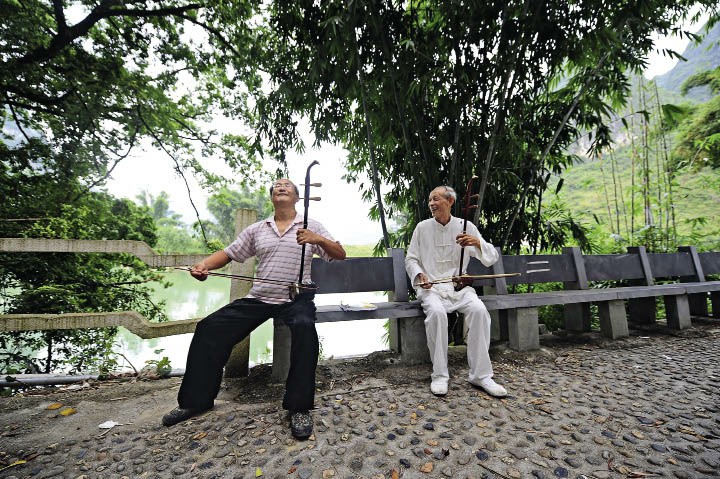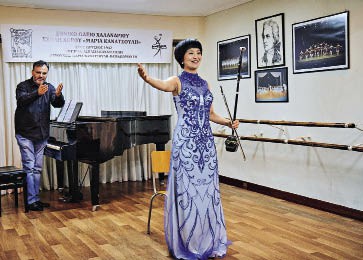Erhu is a traditional Chinese two-stringed bowed musical instrument. It is the most popular of the huqin family of traditional bowed string instruments played in China. “Among Chinese bowed stringed instruments, erhu is the most widely used in a variety of folk arts,” said professor Li Ying of Minzu University of China. When Li was little, she started to learn how to play erhu from her father who was an erhu lover. Later when she was 15 years old, Li began advanced studies of erhu at a local conservatory. “I became captivated by its unique sound the first time I played it,” she said, then added, “Even though it only has two strings, they can produce quite expressive music.”

Two seniors enjoy playing erhu together in Bama Yao Autonomous County, Hechi City of Guangxi Zhuang Autonomous Region.
A Popular Musical Instrument
The modern erhu developed from a musical instrument that was played by many ethnic minorities during the Tang dynasty (618-907) called xiqin. In the Song Dynasty (960-1279), musicians had already begun to use this type of huqin to perform a variety of melodies, and thus it became quite a popular instrument among the society. As it was mainly played by ordinary people and the playing technique was passed down by oral tradition, there are few written records about erhu that can be found in antiquity. To study about the history and evolution of erhu, historians usually reference ancient paintings, sculptures, and murals. The earliest images of this instrument were found in Yulin Cave and Eastern Thousand Buddhist Cave (both of these caves are part of the Mogao Grottoes, a world heritage site on the ancient Silk Road) in Gansu Province, where five erhu images were discovered on the murals. Examining these valuable murals, experts found that erhus during the time the murals were painted already showed great resemblance to the modern erhu in terms of its holding position and playing techniques.
With the rise of some folk art forms, including orchestra, cross-talk, and local operas, erhu playing underwent a historical evolvement during the Ming (1368-1644) and Qing (1644-1911) dynasties. The emergence of tune art (a singing style in opera) especially brought about a significant development in the art of erhu. It also become an important accompanying instrument in a variety of folk operas and even a lead accompanying instrument in some operas.
Modern Development
According to professor Li, erhu underwent major developments in the 20th century, which can be divided into four stages.
The first stage refers to the period from 1915 to 1949, with artists Liu Tianhua and Abing laying a foundation for erhu’s modern evolvement.
The next stage from 1949 to 1979 saw booming development of the erhu playing art, in the opinion of many experts, owing to the founding of the People’s Republic of China. During the post-war period, social stability and people’s broadened aspirations for richer and colorful cultural experience created an enabling environment for the development of traditional arts. Systematic education gradually came into place during that period with music academies established across the nation, and experienced erhu performers were hired as teachers at those academies. Erhu artists in this period inherited Liu Tianhua’s principle of infusing Chinese tunes wtih Western musical influences, as well as Abing’s traditional folk vibes, thus creating a set of sophisticated and professional playing techniques. In addition, many erhu performers tried to compose erhu music, leading to the creation of a number of erhu works, the likes of which had never been heard before.
The third stage from 1979 to 1999 features new explorations and innovations. Various genres of erhu works emerged, including concertos, narratives, and rhapsody. There were also bold innovations in playing techniques and musical expressions that broke through traditional styles and added a modern touch to erhu works.
The fourth stage occurred in the 21st century and was characterized by individualism. Representative erhu performers began to integrate traditional playing techniques with some avant-garde playing styles that require remarkable skills.
A Two-Stringed Art
An erhu is composed of a soundbox, a neck, two strings, two tuning pegs, and a bow. Erhus used for professional performance are commonly made out of red sandalwood or mahogany, one side of the soundbox is covered by a patch of snake skin, and the two strings are suspended along the neck of the instrument.
Professor Li introduced that the soundbox is a very important part of the instrument. By moving the bow back and forth, the strings produce a vibrating sound that resonates through the skin. The texture and shape of the soundbox directly affect the tune quality. The soundbox can be made in various shapes. As the soundbox consists of several pieces of boards, the side wall can be hexagonal, octagonal or round in shape. Today, some erhu makers even try to make a soundbox from a whole piece of wood by just hollowing it out.
What’s noteworthy is that one side of the soundbox is covered by snake skin. Professor Li explained, “In recent years, we have been working on finding ways to replace snake skins with artificial materials.” Now, animal welfare is a priority to many erhu makers. Though artificial skin may not produce a sound that is as good as real snake skin does, erhu performers and makers are committed to finding ways to completely replace the real skin.
“The neck is also important,” Li continued to point out, “for it is the trunk of the body, serving to connect the top with the bottom.” The neck plays a key role during the vibrating and soundmaking process. Besides, it must endure fractions caused by frequent bowing. And because strings are fixed by the pegs on the top and the soundbox at the bottom, the neck must support the pressure caused by the strings. Li noted that the tone of an erhu has a lot to do with the material the neck is made of.
There are two tuning pegs located at the top of the neck. Metal pegs were once used for a period of time in history, but lately the traditional wooden pegs have been making a comeback, as wood pegs tend to produce a better sound and the strings are generally more durable.
Erhu playing techniques include the right and left hand skills. The left hand skills are fingering skills while the right hand skills are bowing skills. One hundred years ago, erhu master Liu Tianhua was inspired by violin playing techniques and innovated erhu playing skills, requiring a coordination of the left and right hand to deliver a variety of styles.

“Song of the Oriental Strings — Li Ying Erhu Concert” is held in Athens, Greece on May 30, 2015.
Innovating and Inheriting
Liu Tianhua devoted his life to the erhu evolution in the early 20th century as a progressive literati. He composed, performed, and taught students, profoundly promoting the evolution of traditional Chinese musical instruments with his commitment to a systematic education of Chinese musical arts. For millennia, erhu had been only performed in local plays, and there had been no solo melodies for erhu as it was mainly seen as an accompanying instrument. In 1915, Liu created the first erhu solo melody called Recitation in Illness. During his 30 years of life, he created 12 erhu solo pieces. In addition, he is also known as a pioneer in designing a systematic education and academic teaching of Chinese folk art, to make it a scientific subject.
Hua Yanjun, usually called Abing, was a well-known folk musician. He grew up in a Taoist temple and began to learn how to play various musical instruments at a very young age though suffering severe visual disablity. Excelled at playing several instruments, he was particularly famous as an erhu virtuoso. As Chinese music was mostly passed down verbally in the past, when Abing heard a piece of melody, he would create his own version of it by adding his own thoughts and understanding to that tune. The technical term for this kind of recreation is called a “variation.” Abing composed three erhu solo variations which were recorded on a wire recorder at the request of two professors from the Central Conservatory of Music. Those three untitled variations of previous tunes were later named The Moon Reflected in the Second Spring, Listen to the Pines and Cold Spring Wind. Unfortunately, Abing died before his next recording appointment.
Today, the number of erhu lovers keeps increasing, both in China and overseas. There are many erhu musical studios and classes in Japan and Singapore. In America, some Chinese American musicians also use erhu to play jazz music. “In China, there are folk music orchestras in many middle and high schools all over China”, Li said, “I’m glad erhu can bring so much joy to so many people.”